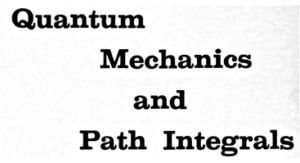
Problem 6-15
Recall that in Prob. 5-4 we defined a particular integral as the transition amplitude to go from state
(解答例) 問題 5-4 では, 次の積分を状態
この量は
そして初期状態を
よって
 経路積分問題
経路積分問題

Problem 6-15
Recall that in Prob. 5-4 we defined a particular integral as the transition amplitude to go from state
(解答例) 問題 5-4 では, 次の積分を状態